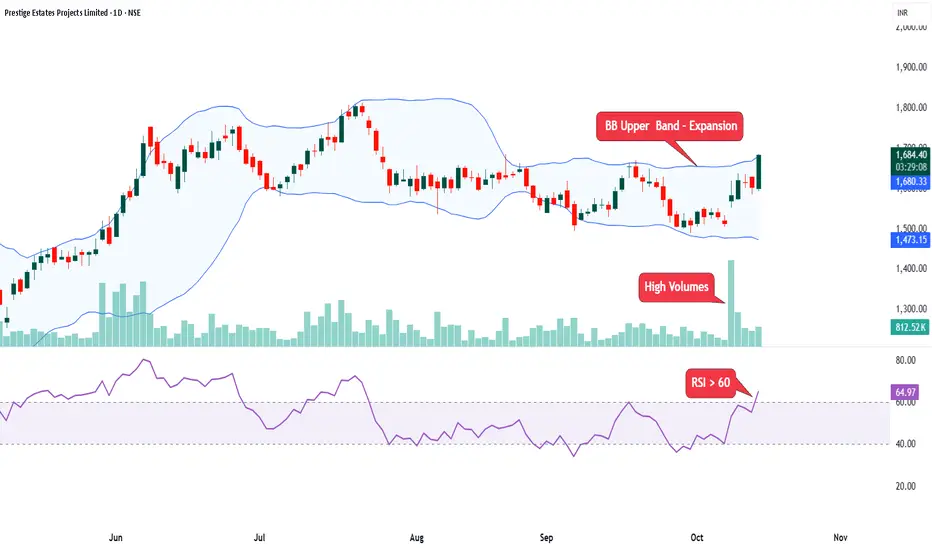This setup shows a strong momentum breakout pattern, combining price action with volume and indicator confirmation. Here’s a step-by-step trading strategy using what’s visible in the chart.
Strategy Overview
1. The upper Bollinger Band is expanding, suggesting volatility is rising and a big move may be starting.
2. Trading volume on the latest bullish candle is much higher than average, confirming buying interest.
3. The RSI is above 60, indicating momentum is in favor of bulls and confirming relative strength.
Entry Point
1. Enter above the breakout candle’s high (near 1680 INR), ideally just above the recent high to reduce false breakout risk.
2. Wait for some price stability above this level (e.g., a 15-minute close above it in live trading).
Stop Loss
1 .Place your stop loss just below the breakout candle’s low (around 1590 INR).
2. Alternatively, set a technical stop below the middle Bollinger Band or a strong recent support (for wider risk tolerance).
Targets
Target 1: Take partial profit near the previous swing high, or measure the width of the Bollinger Bands at the breakout, adding it to the breakout level (approx. 100–150 points move, so target around 1780–1800 INR).
Target 2: Let the rest ride as long as price remains above the middle Bollinger Band and volume stays strong.
Exit Strategy
Exit if price closes back inside the Bollinger Bands after expansion (suggests failed breakout).
Exit on a bearish reversal candle with high volume, or if RSI sharply reverses below 60.
Trading Notes
1. Always size your position according to your risk appetite. Don’t risk more than 1–2% of your trading capital per trade.
2. Use trailing stop-loss orders to lock in profits if the stock moves in your favor.
3. Momentum breakouts work best in trending markets—confirm trend with moving averages or market context.
This approach gives a high-probability setup with disciplined and objective rules based on price, volume, bands, and momentum.
Strategy Overview
1. The upper Bollinger Band is expanding, suggesting volatility is rising and a big move may be starting.
2. Trading volume on the latest bullish candle is much higher than average, confirming buying interest.
3. The RSI is above 60, indicating momentum is in favor of bulls and confirming relative strength.
Entry Point
1. Enter above the breakout candle’s high (near 1680 INR), ideally just above the recent high to reduce false breakout risk.
2. Wait for some price stability above this level (e.g., a 15-minute close above it in live trading).
Stop Loss
1 .Place your stop loss just below the breakout candle’s low (around 1590 INR).
2. Alternatively, set a technical stop below the middle Bollinger Band or a strong recent support (for wider risk tolerance).
Targets
Target 1: Take partial profit near the previous swing high, or measure the width of the Bollinger Bands at the breakout, adding it to the breakout level (approx. 100–150 points move, so target around 1780–1800 INR).
Target 2: Let the rest ride as long as price remains above the middle Bollinger Band and volume stays strong.
Exit Strategy
Exit if price closes back inside the Bollinger Bands after expansion (suggests failed breakout).
Exit on a bearish reversal candle with high volume, or if RSI sharply reverses below 60.
Trading Notes
1. Always size your position according to your risk appetite. Don’t risk more than 1–2% of your trading capital per trade.
2. Use trailing stop-loss orders to lock in profits if the stock moves in your favor.
3. Momentum breakouts work best in trending markets—confirm trend with moving averages or market context.
This approach gives a high-probability setup with disciplined and objective rules based on price, volume, bands, and momentum.
Disclaimer
The information and publications are not meant to be, and do not constitute, financial, investment, trading, or other types of advice or recommendations supplied or endorsed by TradingView. Read more in the Terms of Use.
Disclaimer
The information and publications are not meant to be, and do not constitute, financial, investment, trading, or other types of advice or recommendations supplied or endorsed by TradingView. Read more in the Terms of Use.
